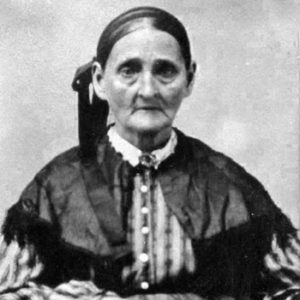calsfoundation@cals.org
Cane Hill Murders of 1839
On June 15, 1839, William Carter Wright of Cane Hill (Washington County) and four of his children were murdered in their home. Their slaying led to the impromptu trial and lynching of four men, conducted by the Cane Hill Independent Regulating Company, a “citizens’ vigilante group.” The brutality of the Cane Hill Murders and the nature of the hearings reflect the potential for lawlessness in the border region in the early history of the state.
On the night of June 15, 1839, Nancy Wright (referred to as Frances in some sources) awoke when she heard horses and men outside the Wrights’ cabin. The sounds alarmed her, and she woke her husband, telling him that she thought Indians were approaching. Three men walked to the house. One of them called out, asking if they could spend the night in the cabin. William Wright opened the door and was immediately killed by the three men. His wife saw what happened and ran out of the house, running to neighbor Charles M. McClellan’s cabin. The Wrights’ oldest daughter also fled the house. After killing William Wright, the men turned on the children and killed a baby, two young girls, and a boy. Another boy was badly injured. The killers stole the money they found, set fire to the cabin, and ran away. The three children who were still alive dragged all but two of the children’s bodies, as well as that of their father, out of the fire.
The next morning, after viewing the horrible scene, local citizens started investigating the murders. The attack was suspected by some to be the work of Cherokee—as the attackers apparently intended—but suspicion quickly turned toward settlers who were seeking money. The Cane Hill Independent Regulating Company, a group of thirty-six prominent men, took charge of the investigation. Seven men were initially arrested, but they furnished alibis and were released. A couple of weeks after the men were released, one of the men, Asbury Richmond, was reportedly heard accusing his brothers of killing the Wrights and of damaging his reputation. Richmond was interrogated by eight men, and three more suspects were arrested from the information he gave them. The men were John Richmond, James Barnes, and Jackson Turner. William Bailey was also wanted but could not be found.
No official trial was ever held, but a panel selected from the regulating company conducted a hearing on July 26 or 27. Witnesses came forward, but their evidence would not have been acceptable in a normal court of law. The accused were not allowed to face their accusers, and their alibis for the night of the crime were ignored. John Richmond pleaded his innocence but, after attempting to escape, decided to confess. Richmond—who had been whipped and beaten during his questioning—told the court that a man named Jack Nicholson was the leader and that he had talked to Nicholson about robbing Wright the day before the murder. After the robbery and murder, Nicholson was given the money, and the men split up. Nicholson escaped and was never caught.
Barnes and Turner denied their guilt, but all three men were hanged on July 29, 1839, in a settlement called Hillsboro at Cane Hill. William Bailey was eventually caught and hanged in December 1839.
Later literature has suggested that the illegal nature of the hearings and executions amounts to a lynching rather than an exercise of justice. Alfred W. Arrington, a lawyer and resident of Fayetteville (Washington County) at the time, was appalled when he heard about the nature of the hearings. He wrote about them in a book called The Desperadoes of the South-West containing an account of the Cane Hill murderers, together with the lives of several of the most notorious regulators and moderators of that region (1847), but the book was highly romanticized, and Arrington claimed that the men who were hanged had been innocent. According to Arrington, two Native Americans by the name of Starr came to Fayetteville about two years after the hearings, confessing that they had killed the Wrights. Others also believed that the men who were hanged had been innocent, including John H. Rhea, who lived in the county at the time of the hearings (but was very young at the time). Rhea said that Tom Starr confessed to the crime. While the Cane Hill Murders were highly publicized throughout the nineteenth century, contemporary researchers must rely upon newspaper accounts and later retellings of the events, as other documents relating to the crime and hearings have not been preserved.
For additional information:
“The Cane Hill Murder.” Arkansas Gazette. September 18, 1839, p. 3.
History of Benton, Washington, Carroll, Madison, Crawford, Franklin, and Sebastian Counties, Arkansas. Chicago: Goodspeed Publishing Co., 1889.
McClellan, Charles M. Letter to editor, Arkansas Gazette. July 31, 1839, p. 2.
“Murderers Hung.” Arkansas Gazette. August 7, 1839, p. 2.
Rhea, J. H. Thirty Years in Arkansaw. Cedar Rapids, IA: Republican Printing Co., 1896.
“Washington County Murder.” Arkansas Gazette. July 17, 1839, p. 2.
Williams, Charles G. “The Cane Hill Murders of 1839 in History and Literature.” Arkansas Historical Quarterly 29 (Autumn 1970): 209–214.
Worley, Ted R. “The Story of Alfred W. Arrington.” Arkansas Historical Quarterly 14 (Winter 1955): 315–339.
Shelby Watkins
Little Rock, Arkansas
Staff of the CALS Encyclopedia of Arkansas
 Early Twentieth Century, 1901 through 1940
Early Twentieth Century, 1901 through 1940 Nancy (Wright) Abbott Wicker
Nancy (Wright) Abbott Wicker 




Comments
No comments on this entry yet.